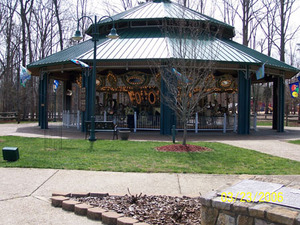West Virginia’s nickname is “Mountain State.” The origin of the name was suggested by Sir Walter Raleigh around 1584. Queen Elizabeth I, who was known as the “Virgin Queen,” was his inspiration. Our current state motto is “Montani Semper Liberi,” which translates to “Mountaineers Are Always Free.” West Virginia seceded from Virginia on June 20, 1863 and is the only state in the Union to have acquired its independence by proclamation of the President of the United States. Nearly 75% of West Virginia is covered by forests. The state has a population of about 1.8 million.
West Virginia’s state flag, adopted in 1929, depicts the West Virginia Coat of Arms centered on a white field, which is bordered by blue on all sides. The date of secession from Virginia on June 20, 1863, is etched into the stone around which the two men stand. One is a miner, the other a farmer. A red ribbon above the two men reads “STATE OF WEST VIRGINIA.” A ribbon below them proclaims the state motto. Around the picture is a wreath of rhododendron.
The largest city and capital of West Virginia is Charleston. Major industries include tourism, farming, chemical manufacturing, glass production, and coal mining. Major rivers and lakes include the Ohio, Guyandotte, and Greenbrier rivers; and the Tygart and Bluestone Lakes.
Highest and lowest points in West Virginia are Spruce Knob and the Potomac River, respectively. Many animals serve as state symbols. The state animal is the black bear. It is actually a deeply tinted brown, not black at all, and reaches an average maximum weight of about 250 pounds.
The state bird became the cardinal by Concurrent Resolution of the 1949 Legislature. The male cardinal is a rich red color, while the young and the females are a less brilliant color.
The Monarch butterfly became West Virginia’s official state butterfly on March 1, 1995. The orange and black butterflies you see during spring are the great grandchildren of those that lived in Mexico during the winter. The honeybee is the state insect, which was introduced to the region during colonial times.
The brook trout, a most-sought-after trout by anglers, is the state fish. It lives in cold, spring-fed streams and is unable to withstand warm temperatures.
On January 29, 1903, the Legislature selected the rhododendron, or “great laurel,” as the state flower, following a vote by students in public schools. You might recognize this shrub by its large, dark green leaves and frail pink or white blooms.
The golden delicious apple was designated the official state fruit by Senate Concurrent Resolution No. 7, and adopted by the Legislature on February 20, 1995. This apple variety was discovered in Clay County in 1905 by Anderson Mullins.
West Virginia’s state tree, the sugar maple, has excellent wood for making furniture, and also produces maple syrup.
The honeybee became West Virginia’s state insect in 2002. In addition to its tasty honey, the honeybee pollinates many important crops, including vegetables, fruits and grasses. Its activity produces more benefit to the state’s economy than any other insect.
The state gem is really a fossil, called the Silicified Mississippi Fossil Coral. This coral and other varieties lived around 340 million years ago, during the Mississippian Period, at a time when the state was encroached on by a shallow sea. Corals look like plants, but they are really animals. This coral is found almost exclusively in the Hillsdale Limestone of Greenbrier and Pocahontas Counties. It became the state gem on March 10, 1990.
Something you might not know is that Mother’s Day, established by Anna Jarvis, was first observed at Andrews Church in Grafton on May 10, 1908. The site of the first 4-H camp in the United States was at Jackson’s Mill. The first sales tax in the United States went into effect in West Virginia on July 1, 1921. The first brick street in the world was laid in Charleston on October 23, 1870, on Summers Street. In 1926, the first women’s prison in the United States was opened in West Virginia. In 1997, West Virginia had the lowest crime rate in the United States.
Jone Johnson Lewis, “Anna Jarvis and Mother’s Day – Mother’s Day History”, About.com Guide
“West Virginia: Facts, Map and State Symbols – EnchantedLearning.com”, EnchantedLearning.com
Timothy R Lovell, “West Virginia Fast Facts and Trivia”, 50States.com



